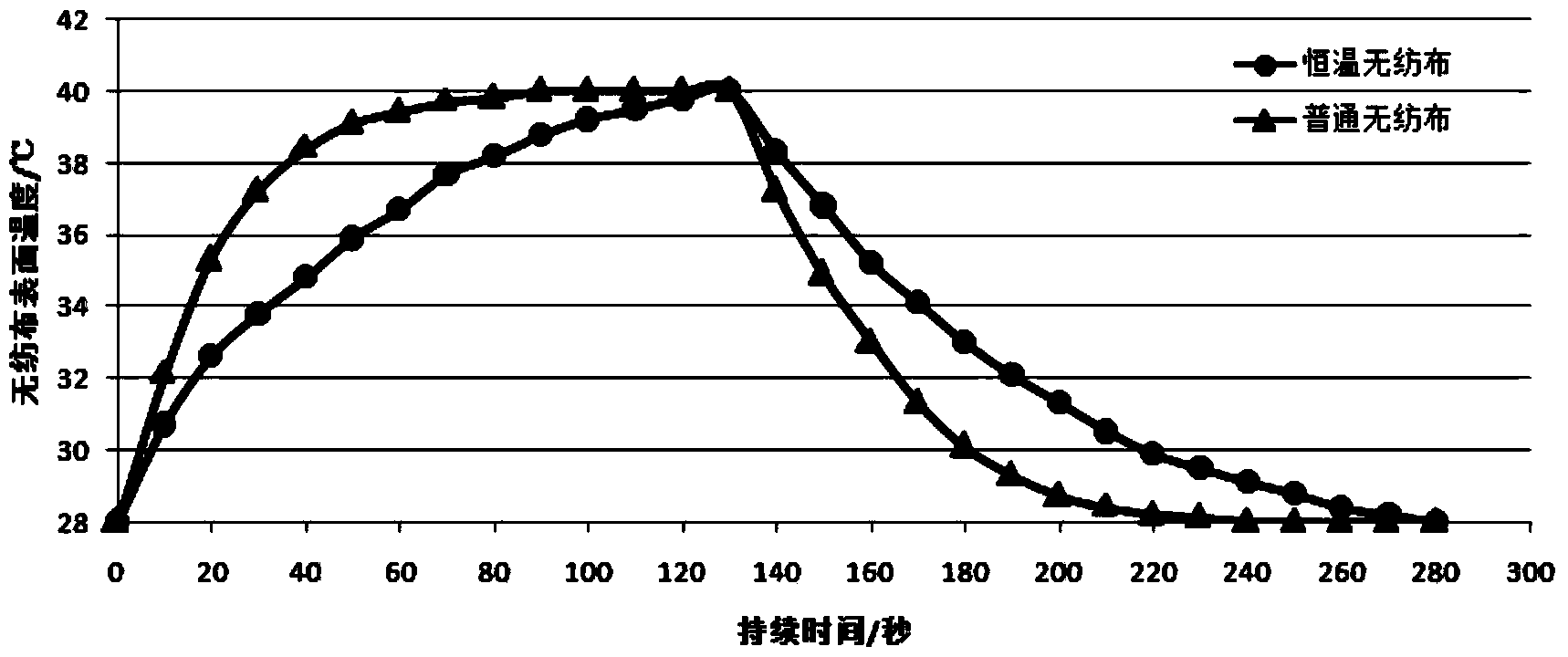Method for manufacturing constant-temperature non-woven cloth for sanitary product
A technology for sanitary products and non-woven fabrics, applied in textiles, papermaking, fiber processing, etc., to achieve the effect of safe use and comfortable sensory experience
- Summary
- Abstract
- Description
- Claims
- Application Information
AI Technical Summary
Problems solved by technology
Method used
Image
Examples
Embodiment 1
[0015] 1) Preparation of microcapsule finishing solution: Prepare a certain amount of aqueous solution containing 2% (w / v) acetic acid and 0.6mol / L calcium chloride, which is the first mixed solution; add 2% (w / v) to the first mixed solution v) chitosan with a deacetylation degree of 60%, fully stir to dissolve, filter, take the filtrate and let it stand overnight at room temperature to obtain the second mixed solution; prepare a certain amount of 3% (w / v) alginic acid Sodium aqueous solution, using this solution as the water phase, drop 20% (v / v) paraffin and 1% (v / v) Span 80 into it at 50°C and let it stand for 10 minutes to obtain a water-in-oil emulsion; take Add 2500mL of the above-mentioned second mixed solution dropwise to 2500mL of the above-mentioned water-in-oil emulsion, and use a stirring device to stir at 600 rpm throughout the dropwise addition. After the dropwise addition, continue to stir for 30 minutes, and then let it stand for 12 hours to obtain microcapsule ...
Embodiment 2
[0030] 1) Preparation of microcapsule finishing solution: Prepare a certain amount of aqueous solution containing 2.2% (w / v) acetic acid and 0.65mol / L calcium chloride, which is the first mixed solution; add 2.5% (w / v) to the first mixed solution v) chitosan with a deacetylation degree of 75%, fully stir to dissolve, filter, take the filtrate and let it stand overnight at room temperature to obtain the second mixed solution; prepare a certain amount of 3.5% (w / v) alginic acid Sodium aqueous solution, using this solution as the water phase, drop 25% (v / v) paraffin and 1.5% (v / v) Tween 80 into it at 52°C and let it stand for 12 minutes to obtain a water-in-oil emulsion; take Add 2250mL of the above-mentioned second mixed solution dropwise to 2500mL of the above-mentioned water-in-oil emulsion, and use a stirring device to stir at 650 rpm throughout the dropwise addition. After the dropwise addition, continue to stir for 35 minutes, and then let it stand for 15 hours to obtain mic...
Embodiment 3
[0034] 1) Preparation of microcapsule finishing solution: Prepare a certain amount of aqueous solution containing 1.8% (w / v) acetic acid and 0.55mol / L calcium chloride, which is the first mixed solution; add 1.5% (w / v) to the first mixed solution v) chitosan with a deacetylation degree of 55%, fully stir to dissolve, filter, take the filtrate and let it stand overnight at room temperature to obtain the second mixed solution; prepare a certain amount of 2.5% (w / v) alginic acid Sodium aqueous solution, using this solution as the water phase, drop 15% (v / v) paraffin and 0.5% (v / v) Span 80 into it at 48°C and let it stand for 8 minutes to obtain a water-in-oil emulsion; take Add 2750mL of the above-mentioned second mixed solution dropwise to 2500mL of the above-mentioned water-in-oil emulsion, and use a stirring device to stir at 550 rpm throughout the dropwise addition. After the dropwise addition, continue to stir for 25 minutes, and then let it stand for 10 hours to obtain micro...
PUM
 Login to View More
Login to View More Abstract
Description
Claims
Application Information
 Login to View More
Login to View More - R&D
- Intellectual Property
- Life Sciences
- Materials
- Tech Scout
- Unparalleled Data Quality
- Higher Quality Content
- 60% Fewer Hallucinations
Browse by: Latest US Patents, China's latest patents, Technical Efficacy Thesaurus, Application Domain, Technology Topic, Popular Technical Reports.
© 2025 PatSnap. All rights reserved.Legal|Privacy policy|Modern Slavery Act Transparency Statement|Sitemap|About US| Contact US: help@patsnap.com



